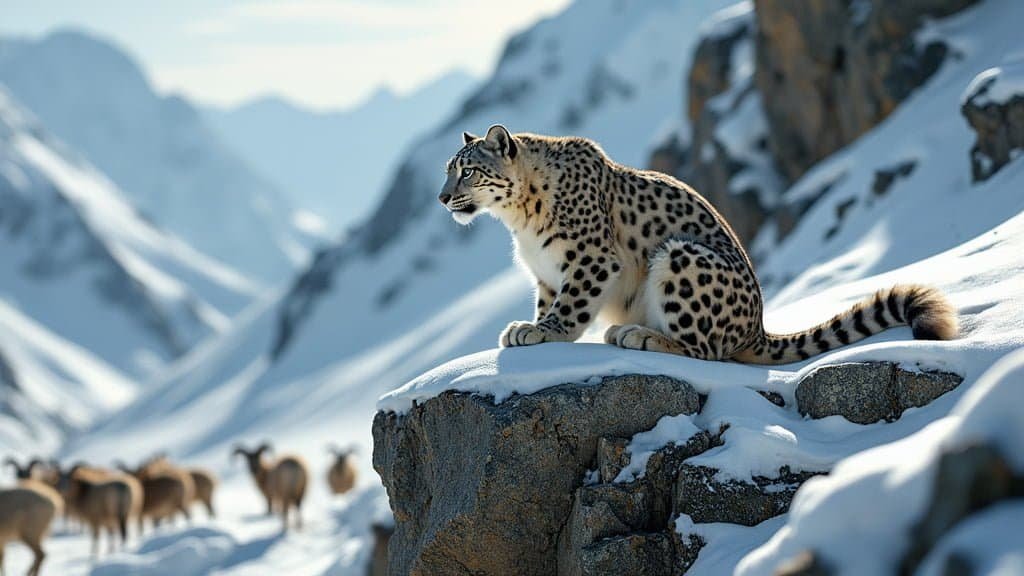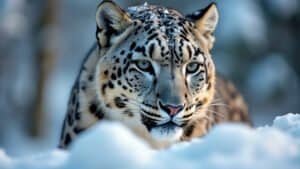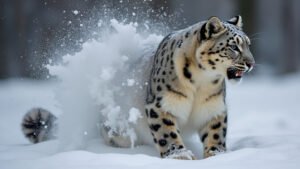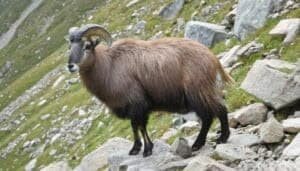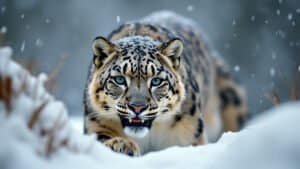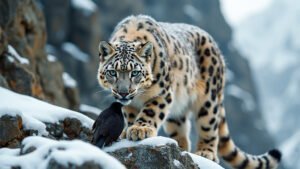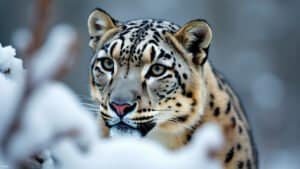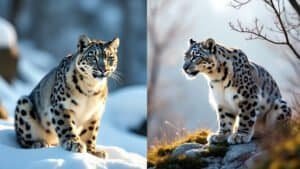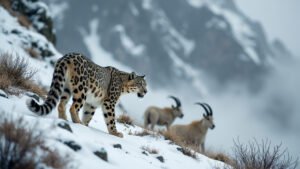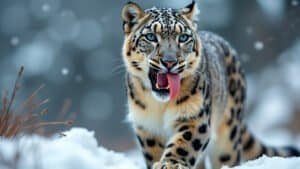Introduction
Snow leopards, the elusive big cats of the high mountains, are master predators, expertly choosing and hunting their prey. In this article, we’ll explore how snow leopards select their prey, examining the primary species they target and how their rugged habitat influences these choices
We’ll also delve into the hunting strategies they employ, their physical adaptations that aid in successful hunts, and how factors like prey availability and human impact shape their diet. Understanding these aspects gives us a deeper appreciation of the snow leopard’s survival skills in one of the planet’s harshest environments
Primary Prey Species of Snow Leopards
Snow leopards, known scientifically as Panthera uncia, are apex predators in the mountainous regions of Central and South Asia. Their prey selection is critical to their survival, influencing not only their hunting strategies but also their distribution across various habitats
Understanding the primary prey species of snow leopards provides insights into their ecological role and the challenges they face in their natural environment
Common Prey: Wild Sheep and Goats
The primary prey of snow leopards consists largely of wild ungulates, particularly wild sheep and goats. Among these, the Siberian ibex (Capra sibirica) and the blue sheep (Pseudois nayaur), also known as bharal, are among the most frequently hunted
These animals are well-suited to the steep, rocky terrains that snow leopards inhabit. The blue sheep, for instance, are highly adapted to mountainous regions, making them a reliable but challenging target for the snow leopard
Studies, such as one published by the Wildlife Conservation Society in 2015, have shown that snow leopards can derive up to 70% of their diet from such ungulates in certain areas
Snow leopards have developed a remarkable ability to take down prey that can weigh two to three times their body weight. This ability is essential for survival, as a single large kill can sustain a snow leopard for several days
The ibex, with its sharp horns and agile movement, presents a significant challenge, requiring the snow leopard to employ stealth and precision during the hunt
Secondary Prey: Smaller Mammals
While ungulates are the primary prey, snow leopards also hunt smaller mammals, especially in areas where larger prey is scarce. Species such as marmots, pikas, and hares frequently supplement their diet
These smaller prey items are often caught during periods when larger prey is less available, such as in the harsher winter months or in areas with lower ungulate populations
Marmots, for example, which are hibernating rodents, are easier to catch in early spring when they emerge from hibernation, slightly sluggish and more vulnerable. According to research conducted by the Snow Leopard Trust, marmots and other small mammals can constitute a significant portion of a snow leopard’s diet during these times
This dietary flexibility is crucial for the snow leopard’s survival in diverse and often challenging environments
Regional Variations in Diet
The diet of snow leopards can vary significantly depending on their geographic location. In the Himalayas, for example, the blue sheep and Himalayan tahr are predominant in their diet, whereas in Mongolia and Russia, snow leopards are more likely to hunt Siberian ibex and Argali sheep
These regional variations in prey preference are influenced by the availability of different species and the specific ecological conditions of each region
In some areas, snow leopards have been observed hunting domesticated animals like sheep, goats, and yaks, especially in regions where wild prey is dwindling due to habitat loss or poaching
This shift not only reflects the snow leopard’s adaptability but also highlights the increasing overlap between human activities and snow leopard habitats. Such interactions can lead to human-wildlife conflicts, which pose a significant threat to the survival of snow leopards
Conservation efforts are increasingly focused on mitigating these conflicts by promoting practices that protect both livestock and the snow leopards
The reliance on specific prey species and the ability to adapt to varying food sources are key to understanding the ecological dynamics of snow leopards
Their prey selection directly affects their distribution, hunting behavior, and even their reproductive success. By studying these aspects, conservationists can better implement strategies to protect this endangered species and ensure its continued survival in the wild
Habitat and Its Influence on Prey Selection
Snow leopards inhabit some of the most rugged and remote mountainous regions in the world, ranging across 12 countries in Central and South Asia, including the Himalayas, the Tibetan Plateau, and the Altai Mountains
The unique characteristics of these habitats play a significant role in determining the prey species available to snow leopards and influence their hunting strategies. Understanding how these factors affect prey selection is crucial for conserving this elusive big cat
Mountainous Terrain and Prey Availability
The snow leopard’s habitat is characterized by steep, rocky terrains, often at elevations ranging from 9,800 to 17,000 feet. These areas are sparsely vegetated, and the harsh environmental conditions limit the diversity and abundance of prey species
The rugged landscape, however, is ideally suited for ungulates like blue sheep and Siberian ibex, which are adept at navigating steep slopes and cliffs. Snow leopards have evolved to hunt in these challenging environments, where their camouflage and agility give them an advantage over their prey
The availability of prey in these habitats is highly variable and is often influenced by factors such as altitude, vegetation cover, and human disturbance. For example, in the Himalayas, snow leopards are more likely to encounter blue sheep and Himalayan tahr, whereas, in the more arid regions of Mongolia, their prey base might consist of Siberian ibex and Argali sheep
Research by McCarthy et al. (2008) highlights that snow leopards in different regions have adapted their hunting techniques to the specific terrain and prey availability of their respective habitats
Elevation and Climate Factors
Elevation plays a crucial role in shaping the prey selection of snow leopards. Higher altitudes, where temperatures are lower and vegetation is sparse, typically support fewer prey species, leading snow leopards to focus on a narrower range of prey, primarily ungulates
The seasonality of prey availability also comes into play at these altitudes. During harsh winters, when snow covers the ground, large prey species like ibex may migrate to lower elevations in search of food, and snow leopards follow, often expanding their hunting grounds
Climate also affects the distribution and abundance of prey species. In areas with significant snowfall, prey species might congregate in areas where food is more accessible, such as south-facing slopes with less snow cover. Snow leopards exploit these conditions by using their thick fur and wide paws, which act like snowshoes, to move silently across the snow and ambush their prey
According to a study published in the Journal of Mammalogy (2014), snow leopards have been observed altering their hunting patterns based on seasonal changes, demonstrating their adaptability to varying climatic conditions
Seasonal Changes in Habitat
Seasonal variations in temperature and food availability force snow leopards to adjust their hunting strategies and prey selection. During the summer months, snow leopards are typically found at higher elevations, where they hunt prey that graze on the alpine meadows
The abundance of prey in these areas allows snow leopards to sustain themselves with larger kills, reducing the frequency with which they need to hunt
In contrast, winter conditions drive both snow leopards and their prey to lower elevations. As vegetation becomes scarce and snow cover increases, prey animals such as ibex and blue sheep descend to valleys and forested areas in search of food
Snow leopards, in turn, follow these movements, often coming into closer proximity to human settlements, which can lead to increased conflict with local communities. In some cases, snow leopards might prey on livestock during these times, a behavior driven by the scarcity of wild prey and the ease of catching domesticated animals
The seasonal shifts in habitat and prey availability require snow leopards to be highly adaptable in their hunting behavior. This adaptability is key to their survival in a dynamic and often harsh environment
Conservation efforts must consider these seasonal patterns to ensure that both snow leopards and their prey species are protected throughout the year. Initiatives such as community-based conservation programs, which involve local populations in the protection of snow leopards and their habitats, have been effective in reducing human-wildlife conflicts and promoting sustainable coexistence
Snow Leopard Hunting Strategies
Snow leopards are known for their stealth and precision when it comes to hunting. Living in some of the most challenging environments on Earth, these big cats have developed highly specialized hunting strategies that allow them to successfully catch prey in the rugged, mountainous terrain they call home
Understanding these strategies sheds light on the snow leopard’s exceptional predatory skills and their role in maintaining the balance of their ecosystem
Stealth and Stalking Techniques
Snow leopards are solitary hunters, relying heavily on stealth to approach their prey undetected. Their spotted coats provide excellent camouflage against the rocky, snow-covered landscapes of their habitats, allowing them to blend in seamlessly with their surroundings
This camouflage is crucial, as it enables the snow leopard to get within striking distance of its prey without being noticed
Snow leopards typically hunt at dawn or dusk, times when the low light conditions further enhance their camouflage. They use the natural cover provided by rocks, ridges, and vegetation to slowly and silently close in on their prey
According to a study published in the journal Biological Conservation (2016), snow leopards often stalk their prey for several hundred yards before making a final sprint, which typically lasts just a few seconds. This strategy minimizes the energy expended and maximizes the chances of a successful kill
Ambush Tactics and Kill Methods
Once within striking distance, the snow leopard uses a sudden burst of speed to ambush its prey. They are known for their incredible agility, able to leap distances of up to 50 feet across gorges or between rocky outcrops
This ability is essential in the steep and uneven terrain where they live, where prey often has the advantage of escaping downhill or across difficult landscapes
Snow leopards typically aim to incapacitate their prey quickly by biting the neck, which either crushes the windpipe or severs the spinal cord, leading to a swift kill. This method is particularly effective for taking down large ungulates like ibex or blue sheep, which can weigh up to three times more than the snow leopard
After the kill, the snow leopard drags its prey to a secluded spot, where it can eat undisturbed. Given the scarcity of food in their habitat, snow leopards will consume as much of the carcass as possible, often returning to the kill site over several days until it is fully devoured
Adapting to Prey Behavior
Snow leopards must continually adapt their hunting strategies based on the behavior of their prey. For example, blue sheep are known to graze in large groups on open slopes, making it difficult for a predator to approach without being detected
To counter this, snow leopards use the natural contours of the landscape to stay hidden as they approach, waiting patiently for the right moment to strike when a sheep strays from the group
Similarly, snow leopards may exploit the vulnerabilities of prey species that are less agile or encumbered by the terrain. Marmots, for example, are easier to catch during their emergence from hibernation in the spring, when they are slower and less alert
Snow leopards also adjust their tactics when hunting smaller prey, using shorter, more direct chases compared to the prolonged stalking used for larger animals
The ability to adapt to different prey behaviors and environmental conditions is a testament to the snow leopard’s versatility as a predator. This adaptability is crucial for survival in the harsh, ever-changing conditions of their mountainous habitats
Moreover, it highlights the delicate balance within these ecosystems, where the predator-prey relationship plays a vital role in maintaining ecological stability
Snow leopards’ hunting strategies are not only a reflection of their physical prowess but also of their deep connection to the landscapes they inhabit. These big cats have evolved over thousands of years to become perfectly attuned to their environment, ensuring their place at the top of the food chain in one of the world’s most challenging ecosystems
Physical Adaptations for Hunting
The snow leopard’s ability to hunt effectively in its harsh, mountainous environment is largely due to a range of physical adaptations that have evolved over millennia. These adaptations enable the snow leopard to navigate rugged terrains, remain undetected, and successfully capture prey that often surpasses it in size and strength
Exploring these physical traits offers insight into the evolutionary success of the snow leopard as a top predator in some of the most inhospitable regions on Earth
Camouflage and Fur Pattern
One of the most striking physical adaptations of the snow leopard is its fur, which serves as both insulation and camouflage. The snow leopard’s coat is thick and dense, providing essential warmth in the freezing temperatures of its high-altitude habitats
The fur is patterned with black rosettes and spots, which, against the backdrop of rocky and snowy terrain, make the snow leopard almost invisible to both prey and potential threats. This camouflage is crucial for a predator that relies on stealth to get close to its prey
The coloration and patterning of the fur vary depending on the region and season, with snow leopards in areas with more snow typically having lighter coats. This variation helps them blend into their specific environments more effectively
According to research published in the journal Molecular Ecology (2013), these variations in fur pattern are a result of both genetic factors and environmental pressures, demonstrating the snow leopard’s ability to adapt to different conditions within its range
Agility and Strength in Pursuit
Snow leopards are incredibly agile, a necessary trait for hunting in the steep, uneven terrain of their mountainous habitats. They possess powerful hind limbs that are longer than their front limbs, which allows them to leap distances of up to 50 feet horizontally and 20 feet vertically
This ability is particularly useful when navigating the rocky outcrops and gorges that characterize their environment, enabling them to pursue prey that might otherwise escape across challenging terrain
Their muscular build and long tail, which can be as long as their body, provide excellent balance during these leaps and when maneuvering on narrow ledges. The tail also serves another purpose: it acts as a blanket that the snow leopard can wrap around its body for warmth when resting
This combination of strength, agility, and balance is crucial for a predator that often hunts on precipitous cliffs where a single misstep could be fatal
Vision and Sensing Prey
The snow leopard’s vision is adapted to the low light conditions of dawn and dusk, which are the prime times for hunting. Their large, greenish-grey eyes have a high density of rod cells, which are responsible for vision in low light
This adaptation allows snow leopards to detect movement from great distances, even in the dim light of early morning or late evening, giving them an advantage over prey that may not be as well adapted to these conditions
In addition to their keen vision, snow leopards have a highly developed sense of smell and hearing, which they use to locate prey across vast distances
Their wide, fur-covered paws are also sensitive to vibrations, which can help them detect the movement of prey or predators on the same rocky surfaces. These sensory adaptations are vital for a solitary predator that often hunts in silence, relying on its ability to detect and approach prey without being noticed
These physical adaptations make the snow leopard one of the most formidable predators in its environment. Each trait, from its fur to its vision, is finely tuned to the challenges of life in the mountains, allowing the snow leopard to thrive in conditions where few other large predators could survive
Understanding these adaptations not only highlights the evolutionary ingenuity of the snow leopard but also underscores the importance of conserving the diverse environments that support such specialized species
Prey Availability and Diet Flexibility
The snow leopard’s survival in the wild is intricately linked to the availability of prey in its mountainous habitat. As a top predator, the snow leopard’s diet is highly dependent on the presence and abundance of certain prey species
However, the harsh and often unpredictable conditions of its environment mean that prey availability can fluctuate, requiring the snow leopard to exhibit remarkable dietary flexibility. This ability to adapt to varying food sources is crucial for its survival and provides insight into the broader ecological dynamics of the regions it inhabits
Impact of Prey Population on Diet
The population dynamics of prey species such as ibex, blue sheep, and other ungulates directly influence the diet of snow leopards. In areas where these large prey species are abundant, snow leopards primarily target them due to the high caloric return per kill
For instance, in regions where blue sheep populations are thriving, studies have shown that they can make up as much as 60-70% of the snow leopard’s diet. This preference is not only due to the nutritional value but also because a single large kill can sustain a snow leopard for several days
However, prey populations are subject to various pressures, including disease, harsh weather conditions, and human activities such as hunting and habitat encroachment. When the population of large prey declines, snow leopards must adjust their diet accordingly
Research conducted by the World Wildlife Fund (WWF) has indicated that in areas with reduced ungulate populations, snow leopards increase their reliance on smaller mammals, birds, and even livestock, showcasing their ability to adapt to changing conditions
Adapting to Scarcity of Prey
In times of prey scarcity, snow leopards demonstrate a high degree of adaptability. They expand their diet to include smaller prey such as marmots, pikas, and hares, which are more abundant but provide less energy than larger ungulates
This shift is particularly evident in winter, when snow covers much of the higher altitude grazing grounds, driving the primary prey species to lower elevations or forcing them into hibernation. During such periods, the snow leopard’s hunting strategy shifts from focusing on fewer, larger kills to more frequent hunting of smaller prey items
This dietary flexibility is also observed geographically. In the more arid regions of the snow leopard’s range, where large prey species are naturally less abundant, snow leopards are known to include a higher proportion of smaller animals in their diet. Additionally, in regions where human activity has reduced the availability of wild prey, snow leopards may increasingly target domesticated animals
This shift can lead to conflicts with local herders, as livestock predation can have significant economic impacts on rural communities. Conservationists are working to mitigate these conflicts by promoting livestock protection measures and compensating herders for losses, thus reducing the incentive for retaliatory killings of snow leopards
Human Impact on Prey Populations
Human activities have a profound impact on the prey populations available to snow leopards. Overhunting of key prey species by local communities or poachers can significantly reduce the food resources available to snow leopards
Habitat fragmentation, driven by infrastructure development, agriculture, and mining, further exacerbates this issue by limiting the space available for both prey and predator. The loss of habitat not only reduces the prey base but also forces snow leopards into closer proximity to human settlements, increasing the likelihood of livestock predation
Conservation initiatives aimed at protecting prey populations are crucial for the survival of snow leopards. Efforts such as anti-poaching patrols, community-based wildlife management, and habitat restoration projects are helping to stabilize and even increase the populations of key prey species in certain areas
For example, in parts of Mongolia and Kyrgyzstan, community-led conservation programs have successfully increased the numbers of ibex and blue sheep, which in turn supports healthier snow leopard populations
Furthermore, conservationists are working to promote coexistence strategies that benefit both local communities and snow leopards. By improving livestock management practices, such as the construction of predator-proof corrals and providing alternative livelihoods, these programs aim to reduce the impact of livestock losses on local economies while simultaneously conserving snow leopard habitats and prey populations
The ability of snow leopards to adapt their diet in response to fluctuations in prey availability is a key factor in their survival. However, the pressures on their prey populations, particularly those driven by human activities, pose significant challenges
Effective conservation strategies must address these issues by protecting both the prey species and the habitats that support them, ensuring that snow leopards continue to thrive in their natural environment
Conclusion
The snow leopard’s ability to select and hunt its prey is a testament to its adaptability and skill as a top predator in some of the world’s most challenging environments
From their preference for large ungulates like blue sheep and ibex to their ability to hunt smaller mammals when necessary, snow leopards have evolved a range of strategies that allow them to thrive in the high-altitude landscapes of Central and South Asia
Their physical adaptations, such as their powerful limbs, keen vision, and camouflaged fur, are perfectly suited to their mountainous habitats, enabling them to stalk and ambush prey with remarkable precision
However, the survival of snow leopards is closely tied to the availability of their prey, which is increasingly threatened by human activities. Habitat loss, poaching, and competition with livestock are significant challenges that disrupt the delicate balance of their ecosystems. Conservation efforts that focus on protecting both snow leopards and their prey populations, while promoting sustainable coexistence with local communities, are essential for ensuring the future of these magnificent big cats
As we continue to learn more about snow leopards and their behavior, it becomes clear that preserving their natural habitats and the species they rely on is not just about saving a single species, but about maintaining the biodiversity and ecological integrity of the entire region
Through targeted conservation initiatives and global awareness, we can help secure a future where snow leopards continue to roam the high mountains, an enduring symbol of the wild and untamed beauty of our planet
